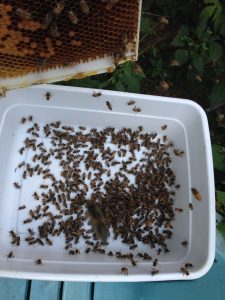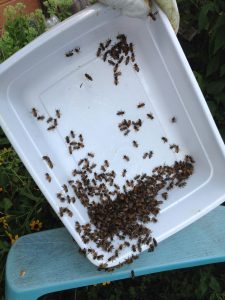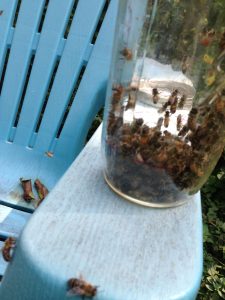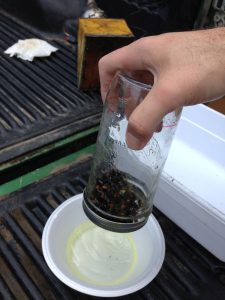Alcohol wash Varroa mite count.
This year I finally got serious about finding out what my mite count is for each hive. By now I am well aware that you can not tell how bad your mites are just by looking at your bees. By the time you notice mites on the bees, or you start finding deformed wing virus, your mite count will be really high. So I put this test kit together mostly with items you can buy at Walmart. There is a plastic tub, a bottle of rubbing alcohol, a wide mouth mason jar and a styrofoam bowl. The mesh is just eighth inch hardware cloth that I cut to fit inside the jar canning ring.
I used a marker to mark the Mason jar at the 1/2 cup mark. 1/2 cup of bees is roughly 300 bees and is what you will usually see recommended as a sampling size. You can also add a strainer fine enough to strain out the mites and you can reuse the alcohol a few times.
So here is my step by step guide how to test for Varroa mites.
The first step is to find a frame or brood that has at least 50% open brood. Some times of year you may not be able to find that much open brood so just try to get close. Make sure the queen is not on the frame! This is really important. The bees you will use to get a mite count in the alcohol wash method will be killed. You don’t want to accidentally kill the queen. If you are unsure if the queen is on the frame or not, then you may want to look through the other frames until you do find the queen. Once you find her, make sure to use a frame the queen is not on.
I don’t like dragging the jar down the frame to knock bees into the jar. I prefer to knock the frame on the bottom of the plastic tub, knocking all the bees into the tub.
Then it is easy to knock the bees into the corner of the tub and pour them into the jar.
Knock the jar down to pack the bees into the bottom and see if they come up to your 1/2 cup mark. There is no sense using more than the 1/2 cup so check it a few times as you poor bees in.
Put the screened lid on and cover the bees with alcohol. A little more than enough to cover them. You want to be able to swirl them around and wash the mites off.
Swirl the bees and alcohol for about 30 seconds.
Then poor the alcohol into the white bowl and shake vigorously for about 10 seconds to dislodge all the mites and shake them into the bowl. As you learn to do this it is a good idea to cover the bees with alcohol a second time and repeat the swirling and shaking process to see if you missed any. If you did, then you probably didn’t swirl or shake long enough or hard enough.
The white bowl helps you to see the brownish red little mites. They can be kind of hard to tell from some of the other debris, but you get the hang of it pretty quick. This hive had 6 total mites (only 4 are visible in the close up photo). The sample of bees should have been 300 bees so 6 mites translates to a 2% infestation (6 / 300 = .02 or 2%). Next you have to decide what threshold you are going to use. Do you put Varroa mite treatments in any hive over 2%. Or any hive over 4%. Or maybe even anything over 1%. That one you will have to decide on your own.
I think it is important that you don’t just blindly treat all your hives. I think it is important to find out your mite counts and then only treat the hives that really need the help. The more often we beekeepers use the current mite treatments the sooner the mites will build up resistance to those treatments.
My mite counts for August 31, 2017
1 2017 NUC #1 from beemindfulhoney.com 2 mites
2 2017 swarm from Team Ford 1 mite
3 2016 Carniolan package (overwintered) 6 mites
4 2017 split from 2016 Carniolan package 30 mites
5 2017 NUC #2 from beemindfulhoney.com 2 mites
6 2017 swarm from Homer NE 1 mite
7 2017 NUC from Cecelia (Rosie) Patterson 1 mite
8 2017 swarm in a bait hive 0 mites
9 2017 cutout from Dakota City NE 6 mites
10 2017 split from 2016 Carniolan package 4 mites
11 2016 Carniolan package
(overwintered and split in spring 2017) 50+ mites
Treated the two worst hives with Apigaurd on September 8th.
I will add the second dose in two weeks. Hopefully I can do a mite count after the treatment and let you know how well the treatments worked.
[jetpack_subscription_form]

















If these hives are in close proximity I would think if you were going to treat 1 you should treat them all. I scraped some drone comb last week and found mites. That really kinda surprised me as I started out this year with 2 hives and now have 8 so there should have been plenty of breaks in the brood cycle. I treated yesterday with oxalic acid and treated them all. I believe they can become resistant to some treatments but I kinda have my doubts they can become immune to an acid and for as cheap as it is I would do them all.
The hive with the mite count of 30 is in-between one with a count of 6 and one with a count of 2. So they are not sharing mites as much as I expected they would. I think I will move the one with 30 somewhere by it’s self before I threat it. Because I want to keep my honey operation treatment free, I will keep that hive separate and I will not use any of the equipment for honey production again. I will probably make NUCs next year and sell the equipment with the bees.
Thanks, John.
How will you treat your hives & which ones?
For now I think I will not treat the hives with a mite count of 6 or less. However, I will treat the hive with a mite count of 30 with Apigaurd. From the manufacturers website at:
http://www.vita-europe.com/products/apiguard/#WhatisApiguard
“Apiguard is a sophisticated, patented slow release gel that ensures correct dosage of its active ingredient, thymol. Thymol is a naturally occurring substance derived from the plant thyme.”
I do not think that just because something is organic based that it is safe. The instructions for Apigaurd say you can not use it with honey suppers on as ” Apiguard may taint honey in supers,”… I want to keep my honey operation treatment free so I will not use the treated hive in my honey production again.
I did get a second treatment of Apigaurd added two weeks after the first. Unfortunately I did not get a chance to do a second mite count to see how effective the treatments have been
I got the results of the mite counts my friend Dean from Adaville Honey Company did this year and I wanted to share them. I think we all may want to try what he did and not just count the mites but count the bees too. You would assume you are always getting around 300 bees but when Dean counted his samples of bees he found one with quite a variation. I think I will do that next year so I can see how accurate I am at getting the right amount of bees in my samples. Dean also included the amount of honey he got from each hive. He averaged just over 100 pounds this year! Way to go Dean and Adaville Honey Company!
Hive 1 2 3 4 5 6 7
Mites/Bees 15/274 34/185 5/273 20/307 5/325 10/310 10/?
Percent of Mites 5.40% 18.30% 1.80% 6.50% 1.50% 3.20% 3.3%?
Honey (pounds) 173.4 136.4 62 47.6 137 87 124